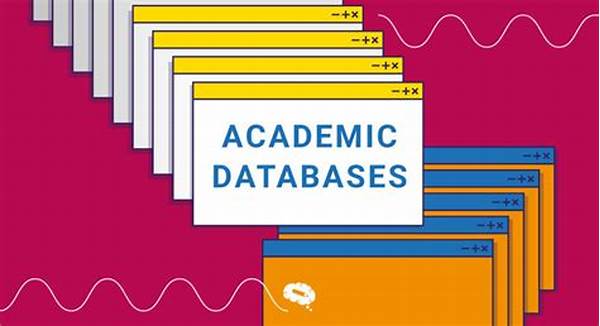Understanding Academic Reference Databases
Academic reference databases are essential tools in the realm of scholarly research, offering researchers, educators, and students access to a vast array of information and resources. These databases house collections of academic journals, articles, papers, and other scholarly work, meticulously curated to facilitate the advancement of knowledge and research. As indispensable resources, they ensure the availability of peer-reviewed and credible research material, contributing to the integrity and reliability of academic work.
Read Now : Building A Solid Thesis Foundation
The term “academic reference databases explained” denotes the comprehensive analysis and understanding of these platforms, emphasizing their significance in the academic world. They serve as central repositories that enable individuals to explore topics in depth, providing access to cutting-edge research across various disciplines. By offering advanced search capabilities, these databases help users locate specific information quickly and efficiently, enhancing the research process.
Furthermore, academic reference databases explained illustrates their role in democratizing access to information. They bridge the gap between researchers and high-quality content, fostering academic growth and innovation. As academia continues to evolve, these databases remain pivotal, adapting to changes in research demands and technological advancements. Ultimately, they are indispensable in promoting a culture of learning and scholarly inquiry.
Key Features of Academic Reference Databases
1. Comprehensive Coverage: Academic reference databases explained highlight their extensive scope, encompassing a wide range of subjects and disciplines. This ensures that users have access to diverse research materials, regardless of their field of study.
2. Peer-Reviewed Content: A hallmark of academic reference databases explained is the provision of peer-reviewed literature, offering users trustworthy and credible resources verified by subject matter experts.
3. Advanced Search Capabilities: Academic reference databases explained emphasize sophisticated search tools, enabling precise retrieval of information and assisting researchers in a focused and efficient manner.
4. Regular Updates: The significance of academic reference databases explained is reinforced by the frequency of updates, ensuring the inclusion of the latest research and developments within various disciplines.
5. Integration with Citation Tools: Academic reference databases explained describe their integration with citation management software, allowing users to seamlessly organize and reference their scholarly work.
The Role of Academic Reference Databases in Research
Academic reference databases are integral components of the research ecosystem, supporting educators, researchers, and students in the pursuit of knowledge. As outlined in “academic reference databases explained,” these platforms offer unparalleled access to comprehensive and authoritative content across myriad fields. They serve not only as repositories of information but also as catalysts for intellectual exploration and discovery.
With the enhanced accessibility provided by academic reference databases, researchers can delve into previously inaccessible studies and findings. The databases empower users to engage with a multitude of perspectives and methodologies, enriching the research process. Hence, academic reference databases explained underscores their role in broadening the horizons of academic inquiry, fostering collaboration and innovation across different fields and institutions.
Frequently Asked Questions About Academic Reference Databases
What is an academic reference database?
An academic reference database, as elucidated in “academic reference databases explained,” is a curated digital platform that provides users with access to scholarly articles, journals, and research papers. These databases compile peer-reviewed content from various disciplines, serving as essential resources for conducting academic research and ensuring access to reliable information.
Read Now : Personal Statement Structure And Format
How do academic reference databases support research?
Academic reference databases explained the provision of comprehensive and up-to-date resources that facilitate scholarly research. They enable researchers to access a wide array of peer-reviewed studies and articles, enhancing the robustness of their work. By offering advanced search functionalities, these databases streamline the research process, allowing users to find pertinent information effortlessly.
Why are peer-reviewed articles important?
As illustrated in academic reference databases explained, peer-reviewed articles undergo rigorous evaluation by experts in the field, ensuring the credibility and reliability of the research. This validation process elevates the quality of academic materials within databases, making them indispensable in supporting sound and valid research endeavors.
How can one effectively use academic reference databases?
In “academic reference databases explained,” it is suggested that users maximize the potential of these platforms by utilizing search filters and keywords to narrow down results. Understanding database-specific features and leveraging citation management tools further enhance research efficiency and effectiveness.
Are academic reference databases accessible to everyone?
While academic reference databases explained highlight their pivotal role in democratizing information, access is often contingent upon institutional subscriptions or affiliations. Many universities and research institutions provide access to these databases, ensuring that students and faculty can benefit from their resources.
Challenges and Considerations in Using Academic Reference Databases
The utilization of academic reference databases, as detailed in “academic reference databases explained,” comes with both opportunities and challenges. Users must navigate the plethora of available resources judiciously, ensuring the selection of pertinent and high-quality materials. Familiarity with the database’s interface and features is essential in effectively extracting the desired information.
Moreover, the requirement for continuous learning and adaptation is paramount, as academic reference databases evolve to incorporate new features and resources. Staying abreast of updates and changes is crucial for maximizing their utility in research. The insights provided by academic reference databases explained underscore the importance of a thoughtful and informed approach, maximizing their role in academic endeavors.
Innovations in Academic Reference Databases
The evolution of academic reference databases, as reflected in “academic reference databases explained,” has been marked by continuous advancements in technology and content integration. Modern databases increasingly emphasize user-friendly interfaces, augmented search capabilities, and personalized recommendations. Leveraging artificial intelligence, these databases offer predictive search functions and automated content curation, streamlining the research process.
Furthermore, academic reference databases explained introduces innovations like open access options and institutional repositories that grant broader access to information. These developments highlight the commitment to enhancing knowledge dissemination and collaboration within the academic community, ensuring that research is accessible, inclusive, and impactful. As these databases continue to evolve, they remain essential in shaping the landscape of academic research and scholarship.
